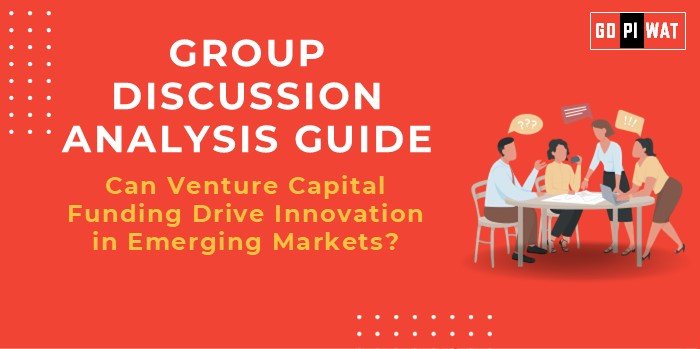📋 Group Discussion (GD) Analysis Guide
Can Venture Capital Funding Drive Innovation in Emerging Markets?
🌐 Introduction to the Topic
Opening Context: Venture capital (VC) funding plays a pivotal role in driving economic growth and innovation. In emerging markets, where access to traditional capital is often limited, VC serves as a catalyst for startups and disruptive technologies.
Topic Background: With over $200 billion invested in startups across emerging markets in the last five years, VC is reshaping industries like fintech, healthtech, and edtech. Its significance grows as governments and private sectors seek sustainable economic models.
📊 Quick Facts and Key Statistics
- VC Investment in Emerging Markets (2023): $78 billion — signaling growing investor confidence.
- Startups Created Annually: 10,000+ in markets like India, Brazil, and Indonesia.
- Unicorn Growth: Emerging markets saw 50+ new unicorns in 2023.
- Impact on GDP: VC-backed firms contributed 2-4% of GDP in select markets.
👥 Stakeholders and Their Roles
- Governments: Create conducive environments through regulations and incentives.
- Venture Capital Firms: Provide funding, mentorship, and strategic partnerships.
- Startups: Innovate in critical sectors like healthcare, education, and fintech.
- International Organizations: Offer funding and technical assistance (e.g., World Bank).
🏆 Achievements and Challenges
🎉 Achievements
- Job Creation: VC-backed firms created over 500,000 jobs in 2022 across emerging markets.
- Sectoral Disruption: Companies like Grab (Southeast Asia) revolutionized transport services.
- Technology Transfer: Increased collaborations with global tech giants fostered innovation.
⚠️ Challenges
- High Failure Rates: 75% of startups fail within five years.
- Access Disparity: VC often prioritizes urban areas, leaving rural markets underserved.
- Global Comparisons: Countries like Israel and the US lead in VC ecosystems due to stronger innovation clusters.
Case Study: India’s fintech boom, driven by VC, exemplifies rapid growth despite regulatory challenges.
🌀 Structured Arguments for Discussion
- Supporting Stance: “VC funding is crucial in bridging the innovation gap by fostering startups that address local challenges in emerging markets.”
- Opposing Stance: “Overreliance on VC funding leads to unsustainable growth and neglects broader economic inclusivity.”
- Balanced Perspective: “While VC funding fuels innovation, complementary policies ensuring equitable access and sustainability are essential.”
📖 Effective Discussion Approaches
-
Opening Approaches:
- Start with a statistic: “VC investments reached $78 billion in emerging markets last year, marking a 25% increase from 2022.”
- Use a regional case study: “In Africa, Flutterwave’s success highlights VC’s potential to drive fintech innovation.”
-
Counter-Argument Handling:
- Acknowledge risks (e.g., unsustainable growth).
- Suggest solutions, like integrating public-private partnerships for broader reach.
🔍 Strategic Analysis of Strengths and Weaknesses
- Strengths: Accelerates innovation, attracts global investors.
- Weaknesses: Regional disparities, startup failure rates.
- Opportunities: Focus on green technologies, expand to underserved regions.
- Threats: Regulatory unpredictability, economic instability.
🏫 Connecting with B-School Applications
- Real-World Applications: Ideal for research in startup ecosystems, finance, and entrepreneurship.
- Sample Interview Questions:
- “How does VC differ from traditional funding in emerging markets?”
- “Can VC-backed innovation be inclusive in rural areas?”


